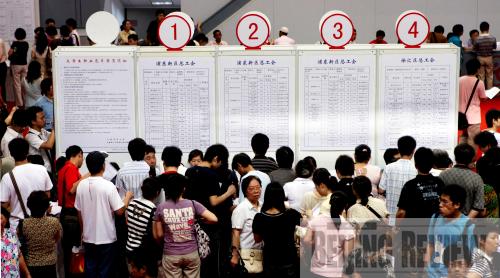|
 |
|
JOB SEARCH: College graduates look for employment opportunities at a job fair in Shanghai (LIU YING) |
As the economic downturn seems to have bottomed out nearly a year after the financial crisis in 2008, the outlook on jobs in China also appears to have seen its worst, though labor shortages in coastal areas continues to grab headlines.
Late last year, the sweeping global recession led to numerous Chinese factories closing in the Yangtze River and Pearl River deltas, sending millions of migrant workers back to their home villages. But now, the latest conundrum is that factories cannot find enough workers to resume full capacity as orders resurge.
In Foshan, a manufacturing hub in south Guangdong Province, the number of job-seekers has remained constant while demands for labor are exploding. According to data from the city's employment service center, vacancies have amounted to 2.28 times that of job-hunters.
Given how bleak China's employment landscape was earlier this year, the demand for workers should be a cause for optimism.
There is no doubt that the job growth was stimulated by a broader economic upturn, as well as forceful government measures that sparked domestic demands, said Yin Weimin, Minister of Human Resources and Social Security, at a recent press conference in Beijing.
Indeed, the government incentives were instrumental in stemming layoffs, as a number of subsidies were given to crisis-stricken small and medium-sized enterprises to alleviate cost pressures. These enterprises can additionally enjoy favorable policies in social insurance if they hire people who are currently looking for jobs.
With stimulus measures taking hold, signs of an initial turnaround are starting to emerge, said Yin. A total of 7.57 million people have been absorbed into the urban workforce since the beginning of this year, fulfilling 84 percent of the annual target, according to the ministry. The registered urban jobless rate, the only official measure of employment, was 4.3 percent, a relatively low level.
A significant positive factor for the low unemployment rate, as the ministry data suggest, was the increase in job creation from June to August as enterprises recovered their financial health. Seeing a warming job market on the horizon, many migrant workers are returning to the cities. In the first eight months of this year, 3.57 million laid-off workers reentered the workforce, meeting 71 percent of the annual target.
However quickly China's employment woes are vanishing, analysts believe they are still not disappearing fast enough to relax the stretched nerves of policy-makers.
"We are well aware of the uncertainties hanging over the job market," said Yin. "As the real economy is yet to gain a solid footing, China still faces an uphill battle for job growth."
"It remains to be seen how the situation unfolds in the coming months since there is a time lag before the economic recovery filters through the employment landscape," he added.
The most daunting challenge is the growing labor surplus. A ministry report showed that the population to be employed in 2009 was an astonishing 24 million, far in excess of the 9 million jobs that the government aims to create. The structural imbalance will be a heavy weight dragging down the job market for a long time, Yin said.
Among the unemployed population there were 8 million laid-off workers and 13 million newly added job hunters, including 6.1 million university graduates. By July 1, the number of unemployed graduates had approached 2 million, leaving the average employment rate of university graduates at a dismal 68 percent.
Mo Rong, Deputy Director of the Institute for Labor Research under the Ministry of Human Resources and Social Security, believes the speed with which new jobs are created is providing an assurance of quick revival. But a more substantial employment upturn requires a significant improvement not only in quantity, but also in the quality of job growth, he said. More efforts are still needed to underpin the foundations of the shaky job market and achieve a multiplier effect that can boost the economy, he added.
Yin agreed, citing that a viable solution is to seriously push through the policy incentives offered by the government. Those measures include encouraging start-up businesses set up by university graduates and home-returning migrant workers, strengthening vocational training for job-seekers and improving public employment services.
The labor crisis in coastal areas may only be temporary as the export industry tries to quickly recover its lost ground, said Yin. "Of course we will also spare no effort to help enterprises find workers that they need," he added. | 